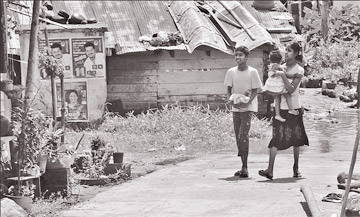Sri Lanka’s successful struggle against poverty
Waruna PADMASIRI
The poverty line is the level of income necessary to achieve an
adequate standard of living. In Sri Lanka the Official Poverty Line (OPL)
is calculated based on consumption of both food and non food items.
A 1989 study by the Medical Research Institute of Sri Lanka lists
daily allowances of calories for Sri Lankans by age and gender and forms
the basis for the official poverty line. The food component of the OPL
is calculated on the basis of the amount of expenditure on food
necessary to meet a minimal nutritional intake of 2,030 kilo calories.
Based on this method, the food component of the poverty line per person
per month was Rs 973 in 2002.
Comprehensive survey
The consumption of non food items (such as shelter and clothing) is
included in the OPL because the welfare of the individual depends on
consumption of items other than food as well. To calculate the non food
component, Department of Census and Statistics (DCS) looks at people who
are on the borderline of food poverty and take their non food
consumption. Under this method the non food poverty line per person per
month was Rs 450 in 2002.
|

Authorities have taken measures to improve the living standards
of slum dwellers. File photo |
Adding the two components gives the Official Poverty Line which was
Rs 1,423 in 2002. This amount is then adjusted to inflation in
accordance with the movement of prices in the Colombo Consumer Price
Index (CCPI). Every month the DCS publishes the updated OPL on their
website.
Adjusted for inflation, the Official Poverty Line was Rs 3, 269 of
expenditure per person per month in November 2011. Basically, if a
person is spending less than Rs 3, 269 per month, he is considered poor.
To measure the rate of poverty, or to see how many people in the
country are under the poverty line, the Department of Census and
Statistics conducts a House-hold Income and Expenditure Survey (HIES).
This is done every three years over a 12 month period using a ‘diary’
method. The survey is probably the most advanced in South Asia,
according to the DCS.
The sample size of the survey is 25,000 households across the island
and it covers every District Secretariat division. The DCS says that Sri
Lanka's high level of literacy, the administrative institutions in the
country, the geographical size and population size allows Sri Lanka to
conduct such a comprehensive survey.
Estate sector
The latest figures from the Household Income and Expenditure Survey
conducted by the DCS shows that the poverty rate in Sri Lanka has
reduced from 22.7 percent in 2002 to 15.2 percent in 2006/7 to 8.9
percent in 2009/10.
The impressive reduction of poverty since 2006 is attributed to the
reduction in poverty levels in the estate sector and in rural areas.
In 2006/7 the estate sector poverty was reported at 32 percent. This
level dropped to 11.4 percent in 2009/10. Three fourths of people in the
estate sector escaped from poverty during this period. According to the
Department of Census and Statistics this is due to the increase in
employment and wages in the estate sector since 2006/7.
Increased accessibility to utilities such as, electricity and
telecommunications facilities could have had an impact on the working
behaviour of people in the estate sector as well.
Similarly, rural poverty dropped from 24.7 percent in 2002 to 9.4
percent in 2009/10. A large portion of this reduction is probably
attributable to the fertilizer subsidy which was given to farmers since
2007. Since an overwhelming majority of the population (nearly 75
percent) of Sri Lanka relies on agriculture for their livelihoods this
policy would have had huge impact.
The poverty line is the amount of expenditure determined by a
scientific method. This amount is deemed to be the minimum expenditure
necessary to meet the basic necessities of life. The poverty rate shows
how many people in the country are failing to meet this requirement.
Household expenditure
There has been some confusion in differentiating between the poverty
line and the average household expenditure. To use an analogy, assume
that the exam pass mark is the poverty line and that the average
household expenditure is the average score, in order to pass the exam
one need not score higher than the average mark. Similarly one need not
spend more than the average household expenditure to be considered not
poor, they need only spend more than the poverty rate.
The average household expenditure is calculated by adding up the
total expenditure of the households surveyed and dividing it by the
sample size. It includes spending on luxury items such as vehicles and
electronic items such as televisions etc. This amount will reflect the
spending habits of the entire population from millionaires to the
impoverished and is not an indicator of poverty.
Similarly it is important to remember that when it comes to household
expenditure, the household is made up of more than just one individual
in most cases and their expenditure is done collectively. For example
though the OPL is set at Rs 3,269 per person per month, which comes to a
little over Rs 100 per person per day, 1kg of rice at a cost of about Rs
50 is sufficient for six people for one meal which comes to about Rs
8.30 for rice per meal. While this level might be insufficient for
people to live in comfort or luxury, according to the DCS it is
sufficient to meet the basic nutritional needs and other expenses.
The Department of Census And Statistics is in the process of
compiling a comprehensive report called the 'Sri Lanka Poverty
Indicators' which is due to be released in the first quarter of 2012. |



